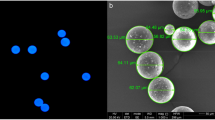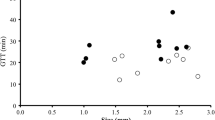Abstract
The paper demonstrates the applicability of fluorescent microparticles (FMP) for the determination of cladoceran feeding rates. For this purpose we examined the relation between filtering rate, ingestion rate, gut passage time and body length of Daphnia pulex at different food concentrations in laboratory experiments, and diurnal changes of filtering rates of Daphnia longispina in in situ experiments, using FMPs as tracer particles. Good agreement of our results with published data based on cell counts and radiotracer methods proves the suitability of the FMP-method. Potentials and limitations of the method are discussed.
Similar content being viewed by others
References
Burns, C. W., 1969. Relation between filtering rate, temperature, and body size in four species of Daphnia. Limnol. Oceanogr. 14: 693–700.
Børsheim, K. Y., 1984. Clearance rates of bacteria sized particles by freshwater ciliates measured with monodisperse fluorescent latex beads. Oecologia (Berlin) 63: 286–288.
Cynar, F. J. & J. McN. Sieburth, 1986. Unambiguous detection and improved quantification of phagotrophy in apochlorotic nanoflagellates using fluorescent microspheres and concomitant phase contrast and epifluorscence microscopy. Mar. Ecol. Prog. Set. 32: 61–70.
DeMott, W. R., 1986. The role of taste in food selection by freshwater zooplankton. Oecologia (Berlin) 69: 334–340.
DeMott, W. R., 1988. Discrimination between algae and artificial particles by freshwater and marine copepods. Limnol. Oceanogr. 33: 397–408.
Dixon, W. J., M. B. Brown, L. Engelmann, M. A. Hill & R. I. Jennrich, 1988. BMDP statistical software manual, Vol 2. University of California Press, Berkley: 843–856.
Evers, E. G. & S. A. L. M. Kooijman, 1989. Feeding, digestion and oxygen consumption in Daphnia magna. A study in energy budgets. Neth. J. Zool. 39: 56–78.
Geller, W., 1975. Die Nahrungsaufnahme von Daphnia pulex in Abhängigkeit von der Futterkonzentration, der Temperatur, der Körpergrö e und dem Hungerzustand der Tiere. Arch. Hydrobiol. Suppl. 48: 47–107.
Gerritsen, J. & K. G. Porter, 1982. The role of surface chemistry in filter feeding by zooplankton. Science 216: 1225–1227.
Gliwicz, Z. M., 1980. Filtering rates, food size selection and feeding rates in cladocerans — another aspect of interspecific competition in filter-feeding zooplankton. In W. C. Kerfoot (ed.), Evolution and ecology of zooplankton communities. Hanover, University Press: 282–291.
Gophen, M. & W. Geller, 1984. Filter mesh size and food particle uptake by Daphnia. Oecologia (Berlin) 64: 408–412.
Haney, J. F., 1971. An it in situ method for the measurement of zooplankton grazing rates. Limnol. Oceanogr. 16: 970–977.
Haney, J. F., 1985. Regulation of cladoceran filtering rates in nature by body size, food concentration, and diel feeding patterns. Limnol. Oceanogr. 30: 397–411.
Haney, J. F. & D. J. Hall, 1973. Sugar-coated Daphnia: A preservation technique for Cladocera. Limnol. Oceanogr. 18: 331–333.
Hessen, D. O., 1985. Filtering structures and particle size selection in coexisting Cladocera. Oecologia (Berlin) 66: 368–372.
Hessen, D. O., T. Andersen & A. Lyche, 1989. Differential grazing and resource utilization of zooplankton in a humic lake. Arch. Hydrobiol. 114: 321–347.
Horton, P. A., M. Rowan, K. E. Webster & R. H. Peters, 1979. Browsing and grazing by cladoceran filter feeders. Can. J. Zool. 57: 206–212.
Kellar, P. E., S. A. Paulson & L. J. Paulson, 1980. Methods for biological, chemical and physical analysis in reservoirs. Tech. Rep. 5, Lake Mead Limnological Res. Center, Univ. Nevada, Las Vegas, 234 pp.
Kerfoot, W. C. & K. L. Kirk, 1991. Degree of taste discrimination among suspension-feeding cladocerans and copepods: implications for detritivory and herbivory. Limnol. Oceanogr. 36: 1107–1123.
Knoechel, R. & L. B. Holtby, 1986. Construction and validation of a body-length-based model for the prediction of cladoceran community filtering rates. Limnol. Oceanogr. 31: 1–16.
Lampert, W., 1974. A method for determining food selection by zooplankton. Limnol. Oceanogr. 19: 995–998.
Lampert, W., 1987. Feeding and nutrition in Daphnia. In R. H. Peters & R. de Bernardi, (eds), ‘Daphnia’. Mem. Ist. ital. Idrobiol. 45: 143–192.
McManus, G. B. & J. A. Fuhrman, 1986. Bacterivory, in seawater studied with the use of inert fluorescent particles. Limnol. Oceanogr. 31: 420–426.
Mourelatos, S. & G. Lacroix, 1990. In situ filtering rates of Cladocera: effect of body length, temperature, and food concentration. Limnol. Oceanogr. 35: 1101–1111.
Muck, P. & W. Lampert, 1984. An experimental study on the importance of food conditions for the relative abundance of calanoid copepods and cladocerans. 1. Comparative feeding studies with Eudiaptomus gracilis and Daphnia longispina. Arch. Hydrobiol. Suppl. 66: 157–179.
Pace, M. L. & M. D. Bailiff, 1987. Evaluation of a fluorescent microsphere technique for measuring grazing rates of phagotrophic microorganisms. Mar. Ecol. Prog. Ser. 40: 185–193.
Peters, R. H., 1972. Phosphorus regeneration by zooplankton. Dissertation. Univ. of Toronto, Toronto, Canada.
Peters, R. H., 1984. Methods for the study of feeding, grazing and assimilation by zooplankton. In J. A. Downing & F. H. Rigler (eds), ‘A manual on methods for the assessment of secondary productivity in freshwaters’. IBP Handbook 17 (2nd edn), Blackwell, Oxford: 336–412.
Peters, R. H., 1987. Daphnia culture. In R. H. Peters & R. de Bernardi (eds), ‘Daphnia’. Mem. Ist. ital. idrobiol. 45: 483–495.
Richman, S., 1958. The transformation of energy by Daphnia pulex. Ecol. Monogr. 28: 273–288.
Rigler, F. H., 1961. The relation between the concentration of food and feeding rate of Daphnia magna Straus. Can. J. Zool. 39: 857–868.
Starkweather, P. L., 1983. Daily patterns of feeding behavior in Daphnia and related microcrustacea: implications for cladoceran autecology and the zooplankton community. Hydrobiologia 100: 203–221.
Turner, J. T., P. A. Tester, R. L. Ferguson, 1988. The marine cladoceran Penilia avirostris and the ‘microbial loop’ of pelagic food webs. Limnol. Oceanogr. 33: 245–255.
Author information
Authors and Affiliations
Rights and permissions
About this article
Cite this article
Wiedner, C., Vareschi, E. Evaluation of a fluorescent microparticle technique for measuring filtering rates of Daphnia . Hydrobiologia 302, 89–96 (1995). https://doi.org/10.1007/BF00027033
Received:
Revised:
Accepted:
Issue Date:
DOI: https://doi.org/10.1007/BF00027033




